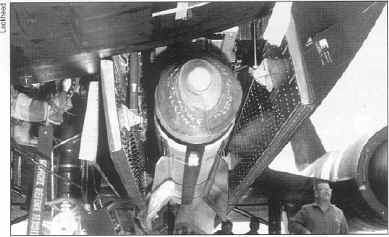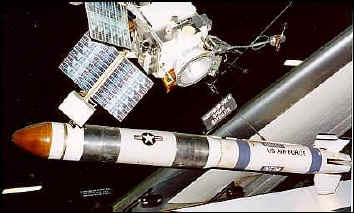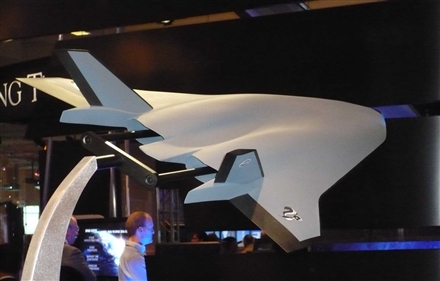SKY RAMP TECHNOLOGY
The United States has made
National Missile Defense a top priority. Billions of dollars have been spent on various
anti-missile concepts, and the most promising is intercepting the missile head-on. This requires that a Mach 5 intercepting missile is directed toward
a Mach 5 ICBM by long-range ground-based radar. As the two objects close at Mach 10, the intercepting missile must detect the infra-red signature
of the oncoming missile and adjust perfectly for a collision. This
remarkable feat has been described as "hitting a bullet with a
bullet". In reality, a bullet travels only about Mach 2, so this is
twice as difficult. In addition, each interceptor missile is a multi-stage
rocket that cost millions of dollars. As a result, testing is expected
to continue over the next ten years to see if this complex system will work.
An anti-missile defense concept
that has not been considered can use technology developed forty years
ago. A Sky Ramp can launch a
ramjet-powered military aircraft to act as an interceptor.
This can be a manned or unmanned aircraft similar to the YF-12 Interceptor,
which was successfully tested in the 1960s (left).
Aircraft on standby in Alaska, Canada, or Greenland could be launched
within minutes and fly at Mach 5 to intercept ICBMs, supersonic bombers, or
cruise missiles approaching the USA. Since ramjet-powered aircraft cannot fly outside the
atmosphere, they are limited to 100,000 feet, or 20 miles high. ICBMs
fly ~200 miles high, so an Interceptor would fire long-range air-to-air missiles upward to hit
one. Another advantage is that a reusable "Interceptor" will not violate the anti-ABM treaty, so it solves
diplomatic problems with
the Russians and NATO allies. 
This is not a theory, the YF-12 once fired an AM-47 Mach 5 missile (right) with a range of 140 miles at 80,000 feet while flying Mach 3.2. An interceptor aircraft provides many advantages over an interceptor missile. It can change course or turn back as suspected targets are reclassified as decoys or space junk. It can fly an arc to intercept at a 90 degree angle so the closure rate is Mach 5 instead of Mach 10. If the interceptor can fly faster than an ICBM, it may be able to shadow a missile from below. It can carry onboard radar to locate the missile and guide missiles toward the target.
The US already uses several types of
air-to-air missiles with a range in excess of 100 miles at sea level. If
fired upward at 80,000 feet, they would encounter no air resistance, so their
range and velocity will more than
double. However, their guidance fins would fail, so they will
need tiny guidance jets like those used by today's NMD interceptors, and by TOW
anti-tank missiles. This allows a ramjet-powered interceptor
to fire several types of low-cost
missiles at a target (and decoys) to ensure destruction. It can fire a missile with a
internal radar seeker (like AMRAAM), a missile with infrared tracking
(like Sidewinder), or a missile guided by the interceptor's radar, (like Phoenix). The Air Force proved this possible when an F-15 fired an ASAT missile (left) to
shoot down a satellite during a 1985 test.
The Air Force proved this possible when an F-15 fired an ASAT missile (left) to
shoot down a satellite during a 1985 test.
With this many options, there is no doubt an interceptor can down one or more ICBMs, supersonic bombers, or low-flying supersonic cruise missiles. The tactics will depend on its speed. The YF-12, which became the SR-71, had a maximum speed of Mach 3.2 with jet engines developed in the 1960s, although sustained speed was only around Mach 2. Ramjets provide more speed since they are not restricted by the heat build-up of the spinning turbine. The FY2009 U.S. Defense budget includes $750 million to build a Mach 5 prototype as an SR-71 successor, dubbed "Blackswift." (below)
 Since Sky Ramps are
needed to launch ramjet-powered aircraft, the problem of recovery may arise if
it lands at a conventional airstrip far from a Sky Ramp. It if has swept wings like the B-1, it could spread its
wings after a mission and glide great distances back home. It may also have a small
internal jet engine which pops out to help power it home. Or, it may be
designed so that ground crews can mount external jet turbine engines to fly
home. This would allow it to operate from any airfield with jet turbine engines, albeit at much slower speeds
than powered by its ramjet engines. Ideally,
the interceptor would be capable of single-orbit missions with ramjet engines
so it can glide home to
its Sky Ramp launch site.
Since Sky Ramps are
needed to launch ramjet-powered aircraft, the problem of recovery may arise if
it lands at a conventional airstrip far from a Sky Ramp. It if has swept wings like the B-1, it could spread its
wings after a mission and glide great distances back home. It may also have a small
internal jet engine which pops out to help power it home. Or, it may be
designed so that ground crews can mount external jet turbine engines to fly
home. This would allow it to operate from any airfield with jet turbine engines, albeit at much slower speeds
than powered by its ramjet engines. Ideally,
the interceptor would be capable of single-orbit missions with ramjet engines
so it can glide home to
its Sky Ramp launch site.
A worldwide Mach 5 Reconnaissance-Interceptor-Bomber (RIB) aircraft is exactly what the U.S. Air Force is seeking for its "Aerospace Force". Aside from its value as a missile and bomber interceptor, it could shoot down low orbit satellites. A reconnaissance version can fill the role vacated by the retirement of the SR-71s. Flying at Mach 5, it could over-fly any country and easily outrun any missile fired to shoot it down. It could also load up with JDAM satellite guided bombs and drop them with impunity. A bomber version could take off from Alaska, drop bombs in China, and land in England within three hours, or possibly circle the globe and return home within five hours. In contrast, it took the subsonic B-2 44 hours of round-trip flying to strike Afghanistan, along with eight air refuelings. In addition, the B-2 is only stealthy at night, and requires hours of skin repair work between missions.
The US Air Force recognizes the need for a fast intercontinental aircraft for its "Global Reach" concept, and the obvious solution is ramjet engines. The major barrier has been a practical method of generating the near mach speed needed for ramjet ignition. Sky ramps are the simple answer, and the assisted launch they provide greatly extends the range of the aircraft.
©2008 Sky Ramp Technology